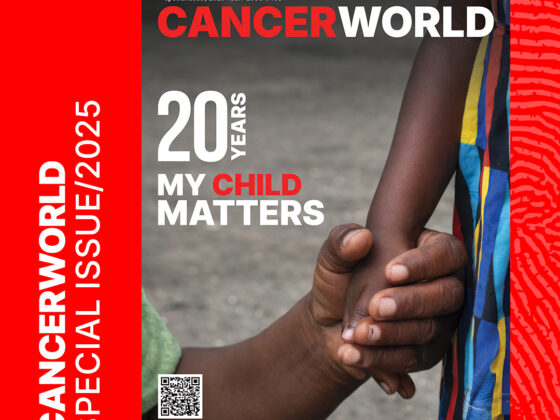Response to therapeutics can differ widely from patient to patient, with some gaining highly significant survival benefits from a therapy that in others elicits no response at all. Patients who respond initially often develop resistance or relapse over time. Not all of this can be explained by tumour genetics. Another factor that is increasingly recognised to play a key role in therapy response is our microbiome ‒ the community of bacteria and other microbes that are our fellow travellers through life. There is emerging evidence that it plays a crucial role in cancer drug response, and that in some cases there is a correlation between the microbiome and resistance to treatment.
The largest microbial communities in animals are found in the digestive tract; they include a complex ecosystem of approximately 300‒500 bacterial species. In general they are considered to exist symbiotically, assisting with the breakdown of food and synthesis of certain vitamins and amino acids.
This means they also interact with the drugs we take orally. “Bacteria are able to produce enzymes that can break down or metabolise drugs,” explains pharmacologist Niall Hyland, from University College Cork, Ireland. “The enzymes that are produced by the microbes could perhaps inactivate that drug, which could have a negative impact, or in some cases it could activate the drug, which could be beneficial.” Even when drugs are not given via an oral route, they may be broken down by the liver and their metabolites secreted into bile and subsequently released into the small intestines, where interaction with the microbiome becomes possible.
More surprisingly, perhaps, we are learning that the field of interactions involving the microbiome is not limited to the gut. “It has become clear in the last decade that bacteria [are] basically everywhere,” says Godefridus Peters, a professor of pharmacology of cytostatics at the Vrije Universiteit, Amsterdam. There is surprising evidence that bacteria are present inside tumours, with the potential to impact drug performance. The extremely low numbers have made this difficult to study, but results published in 2017, by Susan Bullman, from Harvard Medical School in Boston, Massachusetts, showed that the Fusobacterium nucleatum gut bacteria, found to be prevalent in colorectal tumour sites, was also found in distant liver metastases from colorectal primaries.
What is now very clear, says Giorgio Trinchieri from the US National Cancer Institute in Maryland, is that for many drugs, how a patient responds is linked to their gut microbiome. “Certain bacteria species are associated with a good response and certain with a bad response,” he says. The intravenously-administered chemotherapy, gemcitabine ‒ commonly used to treat pancreatic ductal adenocarcinoma, and as an adjunct treatment for certain types of ovarian cancer, non-small-cell lung carcinoma, and metastatic breast cancer ‒ is an example of such a drug.
The emerging evidence
Gemcitabine (2′,2′-difluorodeoxycytidine) is a nucleoside metabolic inhibitor, whose incorporation into cells prevents their division. Peters first became aware of the problem when a cancer cell line in his lab developed a resistance to this cytotoxic. After some investigation, he says, “it appeared that this was due to mycoplasma infection, which would degrade the drug.” Mycoplasma are bacteria with no cell wall, and they are capable of converting gemcitabine into an inactive metabolite (2′,2′-difluorodeoxyuridine). A similar result was published in 2017, but in this case the culprit was gammaproteobacteria ‒ a diverse class of gram-negative microbes. The common factor was their expression of an enzyme cytidine deaminase, which the research team hypothesised was being expressed by intratumoural bacteria. They found 76% of pancreatic ductal adenocarcinomas tested for bacteria were positive ‒ mainly for gammaproteobacteria. Peters has also collaborated on a study to investigate similar resistance patterns with EGFR inhibitors such as osimertinib, a third-generation tyrosine kinase inhibitor used to treat lung cancer.
Another very important result, published in October 2021, has shown how the microbiome may be an important factor in the onset of castration-resistant prostate cancer. In many patients prostate cancer can be controlled by reducing androgen production, but resistance to this treatment can occur, where the treatment is no longer able to lower the patient’s testosterone levels, rendering the cancer much harder to treat. “This inevitably occurs in 10‒15% of patients affected by prostate cancer,” says oncologist Andrea Alimonti, from the IOR Institute of Oncology Research in Bellinzona, Switzerland. Research he carried out as part of an international consortium of researchers, which included analysing the gut microbiomes of 74 resistant and non-resistant patients, together with studies in mice, found an expansion of “peculiar bacterial microflora,” associated with endocrine resistance.
The emergence of endocrine resistance in mice can be delayed by treating them with an antibiotic therapy
The study identified non response with the bacterial species Ruminococcus gnavus. “We have shown that this species of bacteria can actually start to produce androgen from [the] precursor [pregnenolone], which is available in the intestine,” explains Alimonti. Pregnenolone, produced in the pituitary gland, reaches the gut via the liver, and when it gets there is metabolised by Ruminococcus bacteria. “This was really very exciting, because we proved by several experiments that [the Ruminococcus bacteria] can uptake pregnenolone and convert it through into testosterone.” Alimonti was able to show that the emergence of resistance in mice can be delayed by treating them with an antibiotic therapy, whilst a faecal transplant of bacteria from resistant mice can lead non-resistant mice to develop resistance. They now hope to understand whether a specific microbiome signature can predict prostate cancer survival.
Response to immunotherapy has also been linked to the composition of the gut microbiome. Several international studies looking at response to anti-PD1 treatment in patients with melanoma and epithelial cancer have shown an association. A 2018 study of 112 melanoma patients, conducted by Jennifer Wargo from the University of Texas MD Anderson Cancer Center and others, showed significant differences in the diversity and composition of patient microbiomes, with responders having a relative abundance of bacteria of the Ruminococcaceae family. Similar links have been found for anti-CTLA4 immunotherapies, and there is also evidence to show that antibiotics given before or soon after immunotherapy treatment will cause patients to relapse quicker and decrease overall survival.
“Sometimes even patients with a hot tumour will not respond… that may be caused by the microbiota, particularly by gram-negative bacteria”
For a patient to respond to immunotherapy, the tumour must be ‘hot’ ‒ meaning it shows signs of inflammation and infiltration by the T cells that are needed to kill cancerous cells. But sometimes, says Trinchieri, “even patients with a hot tumour will not respond, and we think that may well be caused by the microbiota, particularly by gram-negative bacteria.” These types of bacteria produce large lipopolysaccharide molecules on their outer membrane, and elevated levels of lipopolysaccharide are linked with a number of unfavourable changes in human health.
Mechanisms of action
Research into the link between response to cancer drugs and the microbiome is making some headway but, so far, the mechanisms involved seem to be different for each drug. “[While] they’re clearly not generalisable, they’re probably all true, but that doesn’t mean [the mechanism] is effective in every patient,” says Trinchieri. Alimonti does suggest, however, that the mechanisms he and others have investigated in prostate cancer may also be apparent in breast cancer, which can be promoted by the hormone oestrogen ‒ but the evidence has not yet been collected.
Part of the difficulty in interpreting the evidence stems from the extent to which microbiomes differ from patient to patient. “The gut microbiota can be extremely variable according to the race, sex or geographic location of a specific patient,” says Alimonti. And as Trinchieri points out, the type of microbes present in a person’s gut do not change much over time: “Once the bacterial species are present in the individual, this is more or less fixed for life, although the relative proportion can still change dramatically,” he says. This has meant that studies carried out in different locations often highlight different bacteria as the culprits behind ‒ or indeed the solution to ‒ drug resistance.
Trinchieri’s team recently made a major effort to bring together all the data currently available, which they expect to publish soon. Using data from the American Gut Project, involving 20,000 faecal donors, they have found regional microbiome clusters distributed geographically across the US, and have used this to understand differences observed in cancer drug response data. “You can actually start to get a much more consistent picture. It’s not perfect… it’s not always the same bacterial species, but at least when you [look at] groups of species and so on, you find this consistent among the different studies,” Trinchieri explains. This should start to help with the first step in dealing with the issue ‒ stratifying patients into those who are likely or unlikely to become resistant to a treatment.
“The microbiome can be different at different points during the tumorigenic process”
Adding a further layer of complexity, the pharmacologist Hyland adds that we do have to bear in mind that the disease itself may also create changes in the microbiome. “The microbiome can be different at different points during the tumorigenic process,” he says, “and that of course could then inform how a person might respond to a particular drug. Then maybe we need to be going beyond just looking at a single-point-in-time analysis and really better understand how the microbiome is changing.”
Tackling microbiome-driven resistance
So far, there have been a variety of approaches to dealing with drug resistance. In Alimonti’s prostate cancer study, patients were given antibiotics on top of their standard therapy to prevent the expansion of the resistance-causing bacteria. His team are now undertaking further trials in Switzerland and at the Royal Marsden Hospital in England, with a cocktail of four antibiotics. “We are going to see whether, by doing this, we can achieve a more durable response in patients and we can impact on the circulating levels of testosterone.”
“Antibiotics can alter the microbiome in a negative way… oncologists need to clearly record when treating patients for infections”
But evidence from other studies shows that antibiotics can also alter the microbiome in a negative way. Pharmacologist Peters says this is something that oncologists now need to think about and clearly record, when treating cancer patients for infections. “Oncologists sometimes just mention antibiotics, and do not really specify which type of antibiotic.” Understanding exactly how antibiotics are used is now an imperative, he adds. “There needs to be awareness that the microbiome is playing a role in the treatment of cancer.”
Another treatment option is using probiotics ‒ providing bacteria identified with a positive drug response. In prostate cancer, Alimonti’s team identified several ‘good’ species of Prevotella bacteria associated with non-resistant patients. “We have cultured one of these (Prevotella stercorea) and we have seen that, if you supplement the mouse with this Prevotella, essentially you prevent the expansion of the bad bacteria.” They also showed Prevotella was able to inhibit tumour growth in culture. Alimonti is looking to generate a probiotic that could be used to prevent the onset of castration-resistant prostate cancer, or alternatively a ‘postbiotic’, which would not contain the bacteria itself, but a mixture of the enzymes secreted into culture by the bacteria.
The probiotics approach has not always been successful in other areas, however; for example, a 2008 study of probiotics to treat pancreatitis showed increased risk of mortality. As Trinchieri points out, when you add one species, “you don’t know exactly how you’re going to alter the ecology.” An alternative approach could be faecal microbiota transplantation, which involves administrating a solution of faecal matter from a donor into the intestinal tract of a recipient. “You’re basically replacing one type of ecology with a different type of ecology,” explains Trinchieri. The treatment is currently used to treat persistent Clostridium difficile infections.
“If we continue to supplement them with this faecal microbiome, we delay the occurrence of resistance for a very long time”
Alimonti showed this approach was successful in mice, using transplants from patients or mice sensitive to the hormone therapy. “The mouse never developed castration-resistant prostate cancer. So, if we continue to supplement them with this faecal microbiome, essentially we delay the occurrence of the resistance to standard of therapy for a very long time.” Trinchieri also used this approach for two groups of 25 patients on anti-PD1 immunotherapies. Whilst it was not a controlled study, he says, “the results are dramatic enough to believe in the protocols.” But he does concede, “It’s not obviously [an] ideal type of treatment.” There is of course the concern that pathogens could be transferred inadvertently to a possibly already immunocompromised patient. “The other problem is that we cannot really yet say for sure, ‘use this donor and the patient will respond’,” he adds.
In the long term, there may be solutions in new or improved pharmaceuticals than can counter the negative effects of the microbiome. Trinchieri suggests that, once we have a better understanding of the mechanisms involved in microbiome-mediated drug resistance, “the same pathway could be targeted by small molecules.” Peters says we may be able to take advantage of the difference between human cells, which have a permeable membrane, and the bacterial cell wall. “With a bacterium, the uptake is different… [so] you can design your drug in such a way that it can bypass this.”
The implications for dietary advice
The other important consideration is diet, and the advice patients should be given to try to preserve a healthy microbiome. It probably won’t come as a surprise that high-fibre diets seem to be protective. In December 2021, Trinchieri, in collaboration with several research teams including Jennifer Wargo at MD Anderson, published a study showing that a high-fibre diet was associated with significant improvements in progression-free survival among melanoma patients taking anti-PD-1 immunotherapy. “The amount of fibre in the diet has a clear-cut effect on the response of the patient,” he says.
In mice they demonstrated an impaired response to the drug when given a low-fibre diet or probiotics containing commercially available bacteria, Bifidobacterium longum or Lactobacillus rhamnosus. The positive benefits of a high-fibre diet are of course not limited to impacts on drug resistance, says Hyland. “Fibre that can be converted into short-chain fatty acids tend to have a beneficial effect, and that’s also the case in cancer prevention strategies.”
Another interesting dietary strategy could be eating fermented food, which can alter the microbiome balance. Recent evidence shows these foods can increase microbiota diversity and decrease inflammatory markers, but so far there is no data on its impact on drug metabolism. “In general, a good diversity of foods in your diet as well is going to help promote the healthy microbiome state that we want to achieve,” says Gerard Clarke, a neuropharmacologist from University College Cork, in Ireland.
Clarke has been studying the bidirectional communication between the brain and intestinal functions, which seems to be influenced by the gut microbiota. He has looked at interactions involved with antipsychotic drugs, but has now also started to consider whether there may be similar impacts involving cancer therapies, given that the occurrence of such side-effects also vary greatly from patient to patient. “We’re really just at the tip of the iceberg,” he believes. Clarke has hypothesised that the typical neurological effects, sometime characterised as ‘brain fog’, can be related to the microbiome. “It’s very plausible to us that the microbiota could play a role there,” says Clarke, who has started investigating the symptoms in immunotherapies.
“There may be multiple bacteria that, in the future, could be discovered to impact prostate or another type of cancer”
There is still much to learn about the microbiome and its influence on the treatment of cancer. Alimonti acknowledges the complexity of the microbiome will make it difficult to pin down some of the precise mechanisms causing drug resistance. “There may be multiple bacteria that, in the future, could be discovered [to] impact prostate or another type of cancer,” he says.
While the microbiome is only one among many mechanisms known to play a role in the development of resistance to anti-cancer therapies, its contribution can no longer be ignored. “We probably need to open our minds a bit more,” says Hyland. “We think we know how drugs work, we think they’re affecting DNA synthesis, or our protein metabolism, but actually, there might be an unknown mechanism of action, which involves the microbiome, which is either contributing to drug efficacy or contributing to drug toxicity. We need to take that into consideration.”
Illustration by: Maddalena Carrai












